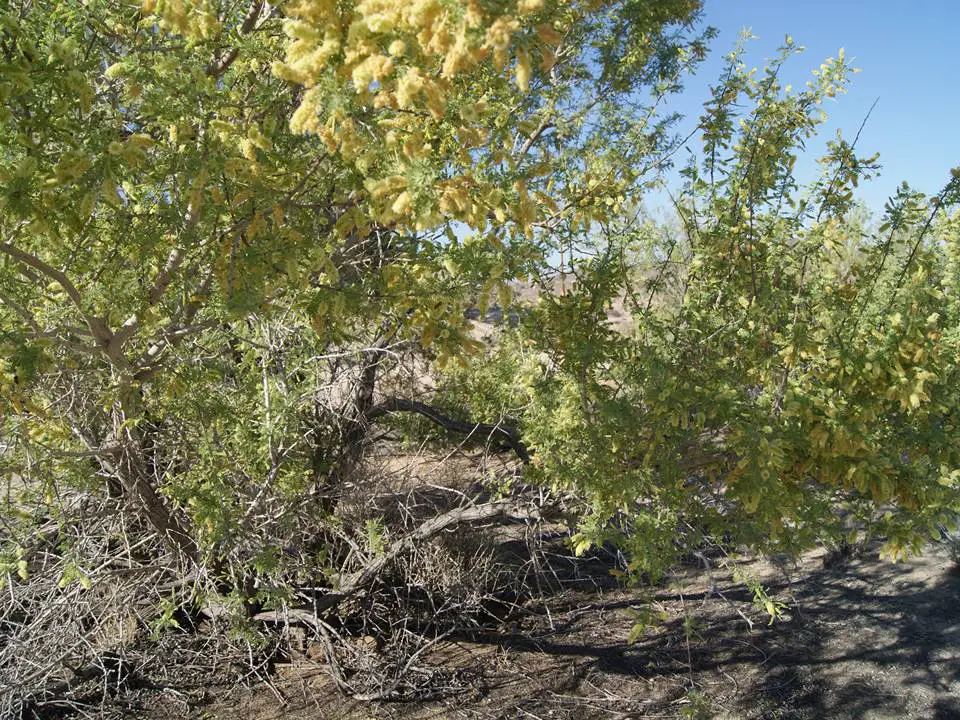The acacia greggii, which can also be colloquially recognized as shorty old and even as a cat, but in general it is mainly identified as Uña de gato, being this type of acacia a species from North America. Its common name is given to it because it has many thorns, the size and shape of which are similar to the claws of cats, so if a person gets hooked, they must stop immediately and carefully disengage so that they do not injure themselves or damage their clothes.
Description of Acacia greggii
Due to its size, the acacia greggii can be considered as a large shrub or as a small tree, depending on how it can be considered, since it can measure up to 10 meters high and have a diameter of up to 30 cm thick.

It has greenish-grey leaves that fall off at certain times of the year, which are made up of up to 3 pairs of smaller leaves that can measure about 3 cm in length and a maximum division of 6 mm between each of them, since at each leaf can have up to 18 of these divisions called leaflets and at the end the tip of these leaves is V-shaped.
When the acacia greggii flowers, it does so in such a way that they are born as many cylindrical spikes, where its flowers have 5 yellowish petals that measure 3 mm and are complemented by many stamens of the same color. It produces legumes that are about 6 cm long and have very strong, dark brown seeds inside.
Distribution and habitat of acacia greggii
Acacia greggii can be seen in regions where there are deep water streams, and these are located so that its root can access these waters.

The seeds of this plant need a scarification process so that germination is faster, but sometimes it could happen that this area is flooded and the seeds remain submerged for a specific time in order to help the seedlings to root deeply and be more likely they can be sustained during droughts. They unfold in dry regions where there are trees that lose their leaves during some times of the year and also where they lose their leaves during most of the year.
The acacia greggii develops glands that produce nectar in parts of the plant outside the flowers, which have strengthened the union between this gland and some types of insects that pollinate and with ants that eat and drink from them so that they can defend them from insects. They eat plants, although sometimes it is attacked with a type of mistletoe found in the desert.
Reproduction of the acacia greggii
 The main development of the acacia greggii has been basically based on the evolutionary anachronism of this species, since its propagation was previously carried out by mammals that ate its seeds and expelled them near this tree, which helped to produce scarification and therefore its germination, but currently this has been very limited by the extinction of many of these mammals that chewed and digested them and then spit or defecated them and over time and under the necessary weather conditions, they began to develop.
The main development of the acacia greggii has been basically based on the evolutionary anachronism of this species, since its propagation was previously carried out by mammals that ate its seeds and expelled them near this tree, which helped to produce scarification and therefore its germination, but currently this has been very limited by the extinction of many of these mammals that chewed and digested them and then spit or defecated them and over time and under the necessary weather conditions, they began to develop.
Toxicity and medicinal properties of acacia greggii
The acacia greggii as well as many other species such as the the narrowest acacia They tend to produce some elements that derive from dimethyltryptamine and, in turn, from cyanogenic substances that are scattered throughout different parts of this plant, such as its bark, seeds, and leaves, so if they are handled incorrectly or ingested, they can be harmful to health. health. Other chemical elements that this plant has could be Beta-methyl-phenethylamine that is used as a fat burner, catechin that is used as an antioxidant, fisetin that is used to strengthen neurons, hordenine that is used as a pain reliever, quercetin is used to prevent cell systems from aging and tyramine which is used as a dietary supplement.
Origin of the acacia greggii
The etymological origin of the acacia greggii, in the case of the acacia, which was given by a botanist from Greece named Pedanius Dioscorides many years before the birth of Christ which is akakia which means thorns; and the word greggi is an adjective given to this plant by a naturalist from northern Mexico and the southwestern region of the United States.
Acacia greggii uses
The acacia greggii is used to make food supplements for livestock, in addition to the stem of this tree tools were made in other times and houses were built.

